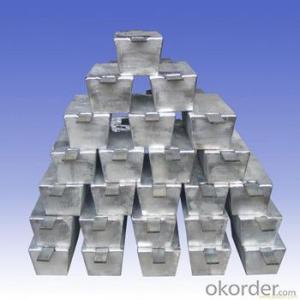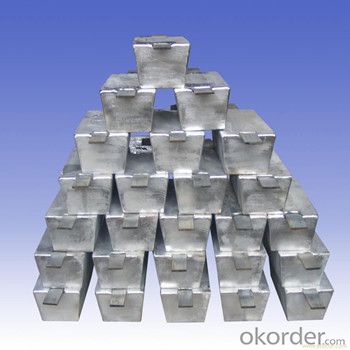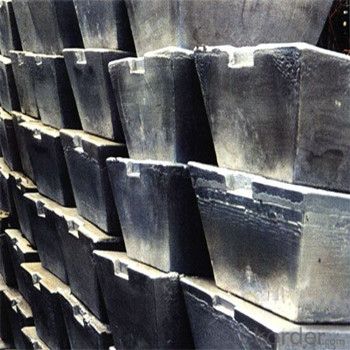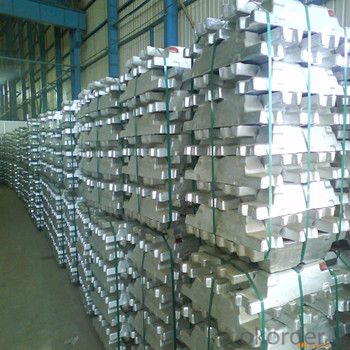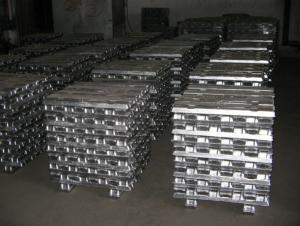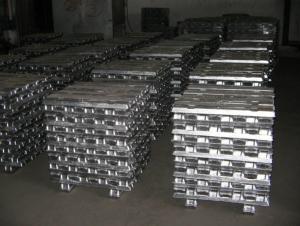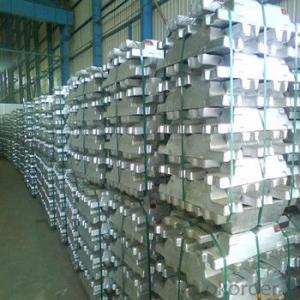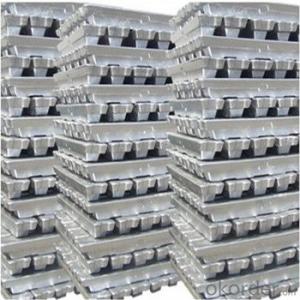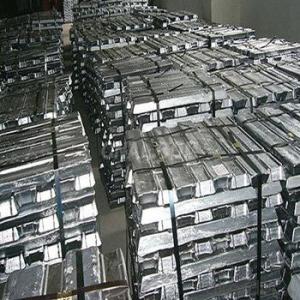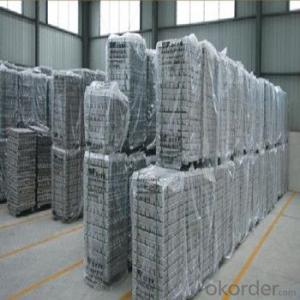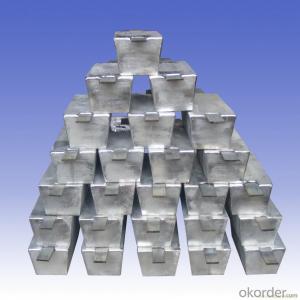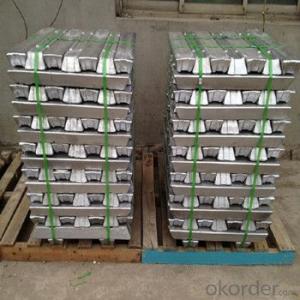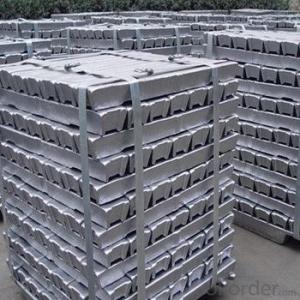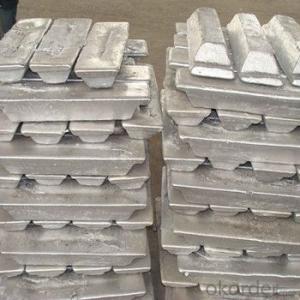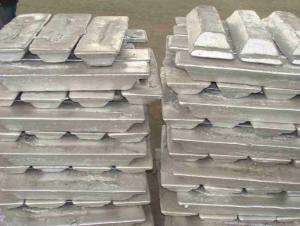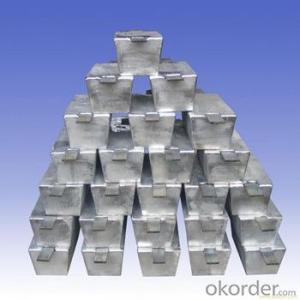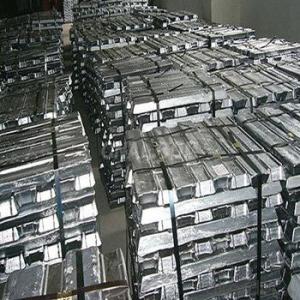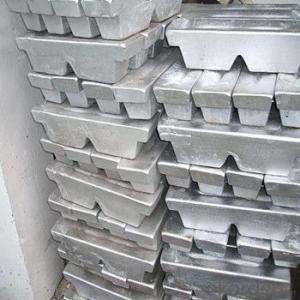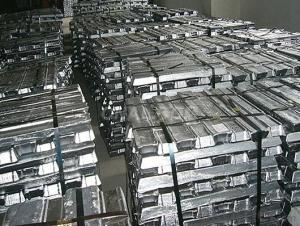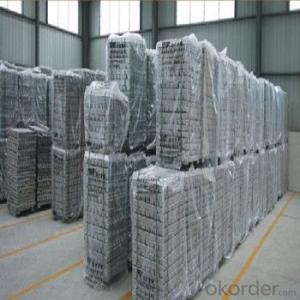Aluminum Ingot Primary/ Pure Aluminium Ingot/Aluminium Ingot 99.7%
- Loading Port:
- China main port
- Payment Terms:
- TT OR LC
- Min Order Qty:
- 1000 m.t.
- Supply Capability:
- 10000 m.t./month
OKorder Service Pledge
OKorder Financial Service
You Might Also Like
Pure Aluminum Ingot Used for Industry
1.Structure of Aluminum Ingot Description
An ingot is a piece of material, usually metal, that is cast into a shape suitable for further processing. Insteelmaking, it is the first step among semi-finished casting products. Ingots usually require a second procedure of shaping, such as cold/hot working, cutting, or milling to produce a useful final product. Non-metallic and semiconductor materials prepared in bulk form may also be referred to as ingots, particularly when cast by mold based methods.
2.Main Features of the Aluminum Ingot
•High Purity
•High strength
•Fast melting
•Best price
•Good after-service
3. Aluminum Ingot Images
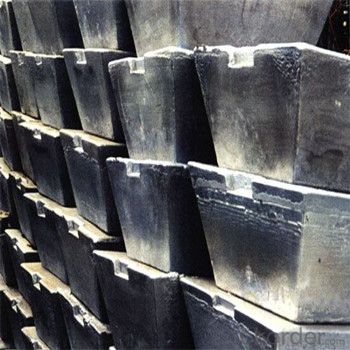
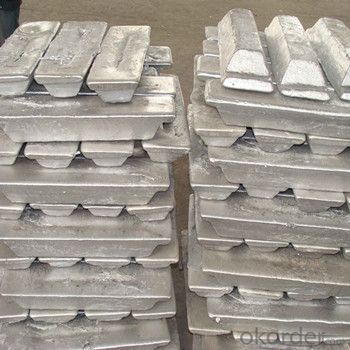
4. Aluminum Ingot Specification
Grade | Chemical Composition % | |||||||||
Al≥ | impurities ≤ | |||||||||
Si | Fe | Cu | Ga | Mg | Zn | Mn | others | Sum | ||
Al99.9 | 99.90 | 0.50 | 0.07 | 0.005 | 0.02 | 0.01 | 0.025 | - | 0.010 | 0.10 |
Al99.85 | 99.85 | 0.80 | 0.12 | 0.005 | 0.03 | 0.02 | 0.030 | - | 0.015 | 0.15 |
Al99.7 | 99.70 | 0.10 | 0.20 | 0.010 | 0.03 | 0.02 | 0.030 | - | 0.030 | 0.30 |
Al99.6 | 99.60 | 0.16 | 0.25 | 0.010 | 0.03 | 0.03 | 0.030 | - | 0.030 | 0.40 |
Al99.5 | 99.50 | 0.22 | 0.30 | 0.020 | 0.03 | 0.05 | 0.050 | - | 0.030 | 0.50 |
Al99.00 | 99.00 | 0.42 | 0.50 | 0.020 | 0.03 | 0.05 | 0.050 | - | 0.050 | 1.00 |
5.FAQ of Aluminum Ingot
We have organized several common questions for our clients,may help you sincerely:
①How about your company?
A world class manufacturer & supplier of castings forging in carbon steel and alloy steel,is one of the large-scale professional investment casting production bases in China,consisting of both casting foundry forging and machining factory. Annually more than 8000 tons Precision casting and forging parts are exported to markets in Europe,America and Japan. OEM casting and forging service available according to customer’s requirements.
②How to guarantee the quality of the products?
We have established the international advanced quality management system,every link from raw material to final product we have strict quality test;We resolutely put an end to unqualified products flowing into the market. At the same time, we will provide necessary follow-up service assurance.
③How long can we receive the product after purchase?
In the purchase of product within three working days, We will arrange the factory delivery as soon as possible. The pecific time of receiving is related to the state and position of customers.Commonly 7 to 10 working days can be served.
- Q: How are aluminum ingots used in the production of electronic devices?
- Aluminum ingots are used in the production of electronic devices in several ways. Firstly, aluminum is a lightweight and durable metal, making it an ideal choice for manufacturing electronic device casings or housings. These ingots are melted and cast into specific shapes to form the outer shells of devices such as smartphones, laptops, tablets, and even gaming consoles. Additionally, aluminum is an excellent conductor of electricity and heat. It is often used as a heat sink material in electronic devices to dissipate excess heat generated during operation. The ingots are processed into heat sinks, which are then integrated into various components like processors, graphics cards, and power modules. The high thermal conductivity of aluminum helps in maintaining optimal operating temperatures and prevents overheating, ensuring the longevity and performance of electronic devices. Moreover, aluminum ingots are also utilized in the production of printed circuit boards (PCBs). PCBs are the backbone of electronic devices, providing a platform for assembling and connecting various electronic components. Aluminum is used as a base material for manufacturing PCBs, providing good mechanical strength and electrical insulation. The ingots are processed into thin sheets that serve as the base substrate for mounting electronic components, creating a solid foundation for the device's functionality. In summary, aluminum ingots play a crucial role in the production of electronic devices. They are used to create lightweight and durable casings, heat sinks for thermal management, and base materials for PCBs. With its excellent electrical conductivity, heat dissipation capabilities, and mechanical strength, aluminum contributes to the overall performance, reliability, and efficiency of electronic devices.
- Q: Production process of aluminium ingot
- Because of the different characteristics of the three kinds of bauxite, different production processes have been adopted in the alumina production enterprises, including Bayer process, alkali lime sintering method and Bayer sintering combined method, three kinds. High grade bauxite is usually produced by Bayer process, and medium or low grade bauxite is produced by combined method or sintering method. Because of its simple process and low energy consumption, Bayer process has become the most important method in the production of alumina at present, and the output is about 95% of the total alumina production.
- Q: What are the advantages of using aluminum ingots in the production of aircraft structures?
- There are several advantages of using aluminum ingots in the production of aircraft structures. Firstly, aluminum is lightweight, which helps to reduce the overall weight of the aircraft. This, in turn, improves fuel efficiency and reduces operating costs. Secondly, aluminum has excellent corrosion resistance, ensuring the longevity and durability of the aircraft structures. Additionally, aluminum is easily formable and weldable, allowing for complex and intricate designs to be achieved. Lastly, aluminum is abundantly available and cost-effective, making it a preferred choice for aircraft manufacturers.
- Q: How are aluminum ingots used in the production of automotive parts?
- Aluminum ingots are used in the production of automotive parts as they are melted and cast into specific shapes to create components such as engine blocks, cylinder heads, wheels, and transmission housings. The lightweight and high strength properties of aluminum make it an ideal material for improving fuel efficiency, enhancing performance, and reducing overall vehicle weight. These ingots are processed through various techniques like casting, forging, and machining to manufacture durable and efficient automotive parts.
- Q: Process description of aluminium ingot
- The commonly used method for casting blend furnace can be divided into two ways of casting casting and continuous casting and continuous casting and vertical semi continuous casting. Continuous casting machines are used. The mixing furnace is to pour the aluminum liquid into the mixing furnace and to be poured by the mixing furnace. It is mainly used for the production of remelting ingots and casting alloys. Casting is carried from ladle directly to casting machine, mainly in the casting equipment can not meet the production, or the quality of raw materials is too poor, can not be directly into the furnace. Since there is no external heating source, the lifting package has a certain temperature, usually in summer at 690~740 degrees, and winter at 700~760 degrees, to ensure a better appearance of aluminum ingots.Mixing furnace, the first to go through the ingredients, and then poured into the mixing furnace, stirring evenly, and then add flux refining.
- Q: What are the challenges in recycling aluminum ingots?
- Recycling aluminum ingots presents several challenges that need to be addressed. To begin with, a major obstacle is the collection and sorting of aluminum waste. Unlike paper or plastic, aluminum waste is often mixed with other materials, making separation and sorting difficult. This necessitates the use of advanced sorting technologies and manual labor, which can be time-consuming and expensive. Additionally, the energy-intensive nature of aluminum production poses a challenge. Although recycling aluminum requires less energy than primary production, it still requires a significant amount of electricity. The process of melting down and purifying aluminum ingots requires high temperatures, which consume a considerable amount of energy. Furthermore, contamination is a persistent issue in recycling aluminum ingots. Even with advanced sorting technologies, it is difficult to guarantee that recycled aluminum is free from impurities. Contaminants like paint, coatings, or other metals can negatively impact the quality of the final product, making it less appealing to manufacturers. Moreover, transportation logistics present another challenge in the recycling process. Aluminum ingots are heavy and bulky, making their transportation from collection centers to recycling plants costly and challenging. This adds to the overall expenses of recycling. Lastly, the global market demand for recycled aluminum can fluctuate, making it challenging for recyclers to find buyers for their ingots. Economic factors, such as the price of primary aluminum and the demand for recycled materials in the market, can impact the profitability and feasibility of recycling aluminum ingots. Despite these challenges, recycling aluminum ingots remains a crucial practice due to its environmental benefits and the conservation of valuable resources. Continued research and innovation in recycling technologies can help overcome these challenges and make the process more efficient and cost-effective.
- Q: What is the role of aluminum ingots in the production of aircraft?
- Aircraft production heavily relies on aluminum ingots because of their unique properties and characteristics. In essence, aluminum ingots, which are blocks or bars of pure aluminum, serve as the primary raw material for making various components and structures in aircraft. The outstanding strength-to-weight ratio of aluminum ingots is one of the main reasons why they are preferred in aircraft production. Aluminum is a lightweight metal, making it perfect for aerospace applications where reducing weight is crucial for fuel efficiency and overall performance. By using aluminum ingots, manufacturers can create lightweight parts that contribute to reducing the overall weight of an aircraft. This leads to improved fuel economy and increased payload capacity. In addition, aluminum ingots possess remarkable corrosion resistance, even in harsh environments. This property is particularly important for aircraft as they are exposed to different atmospheric conditions, including moisture, salt, and pollutants. Aluminum's corrosion resistance helps ensure the durability and longevity of aircraft components, leading to reduced maintenance costs and enhanced safety. Furthermore, aluminum ingots are highly malleable and easily shaped, allowing manufacturers to form them into desired aircraft components through various manufacturing processes such as forging, extrusion, and machining. This versatility enables the production of complex parts, such as fuselage panels, wings, and landing gear, with precision and efficiency. Aside from their mechanical properties, aluminum ingots also exhibit excellent thermal conductivity. This characteristic is valuable in aircraft applications as it helps dissipate heat generated by engines, electronic systems, and other components. By efficiently transferring heat away from critical areas, aluminum contributes to the overall thermal management of an aircraft, enhancing performance and preventing overheating. In conclusion, aluminum ingots are essential in aircraft production due to their lightweight nature, corrosion resistance, malleability, and thermal conductivity. These properties enable the manufacturing of strong, durable, and efficient aircraft structures and components, which ultimately contribute to the safety, performance, and reliability of modern aircraft.
- Q: What are the challenges in recycling scrap aluminum ingots?
- There are several challenges in recycling scrap aluminum ingots. Firstly, one of the major challenges is the collection and sorting of the scrap aluminum. As aluminum is used in a wide range of products, it can be found in various forms and shapes, making it difficult to collect and sort efficiently. This requires an extensive and organized collection network to ensure the scrap aluminum is properly segregated. Another challenge is the presence of impurities in the scrap aluminum. Impurities such as paint, coatings, and other contaminants need to be removed before the aluminum can be recycled. This requires additional processes and treatments to ensure the quality of the recycled aluminum meets the required standards. Furthermore, the energy-intensive nature of aluminum recycling poses a challenge. Recycling aluminum requires melting the scrap ingots at high temperatures, which requires a significant amount of energy. This can be a challenge in terms of cost and environmental impact, as the energy consumption and emissions associated with the recycling process need to be carefully managed. Additionally, the market demand and fluctuating prices of aluminum can pose challenges in recycling scrap aluminum ingots. The availability of cheaper primary aluminum can sometimes make it more economically viable to produce new aluminum rather than recycling the scrap ingots. This can impact the overall recycling rates and the viability of recycling operations. Lastly, the transportation and logistics involved in recycling scrap aluminum ingots can also be a challenge. As scrap aluminum is often collected from various sources, transporting it to recycling facilities can be logistically complex and costly. Efficient transportation networks need to be established to ensure the smooth flow of scrap aluminum to recycling facilities. Overall, while recycling scrap aluminum ingots offers numerous benefits, there are several challenges that need to be addressed to ensure a successful and sustainable recycling process.
- Q: I want to melt aluminum scrap into aluminium ingots. How can I make them?
- Non-standard aluminum ingots without any process requirements, simply put into the melting of aluminum, and then cast into ingots only. Mainly based on your investment, select a smelting equipment. If you want to produce label aluminum ingot, that needs to pay attention to a lot of problems. I'm a recycling plant. I have a production process for recycled aluminum in my room for your reference.
- Q: How to add zinc when producing aluminium ingot?
- Zinc can be directly mixed into the furnace when melting scrap aluminum. In fact, there are many pieces of zinc or zinc aluminum alloy in the waste scrap aluminum. If the ingredients are counted, sometimes they need not be added. The key is to have the method of checking the ingredients. Preferably a spectrum machine.
Send your message to us
Aluminum Ingot Primary/ Pure Aluminium Ingot/Aluminium Ingot 99.7%
- Loading Port:
- China main port
- Payment Terms:
- TT OR LC
- Min Order Qty:
- 1000 m.t.
- Supply Capability:
- 10000 m.t./month
OKorder Service Pledge
OKorder Financial Service
Similar products
Hot products
Hot Searches
Related keywords
